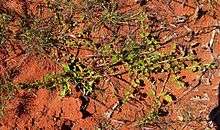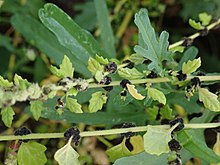Dysphania melanocarpa
Dysphania melanocarpa, commonly known as black crumbweed, is an annual herb that grows in arid and semi-arid regions of Australia.
| Dysphania melanocarpa | |
|---|---|
 | |
 | |
| Scientific classification | |
| Kingdom: | Plantae |
| Clade: | Tracheophytes |
| Clade: | Angiosperms |
| Clade: | Eudicots |
| Order: | Caryophyllales |
| Family: | Amaranthaceae |
| Genus: | Dysphania |
| Species: | D. melanocarpa |
| Binomial name | |
| Dysphania melanocarpa | |
| Synonyms | |
|
Chenopodium melanocarpum | |
Description
It grows as a prostrate aromatic annual, with hairy stems that branch from its base. Leaves are oval in shape, about fifteen millimetres long. Flowers occur in dense clusters located in the axils.[1]
Taxonomy
It was first published in 1922 by John McConnell Black, as a variety of C. carinatum,[2] and promoted to species rank by him in 1934. Two forms have been published, although these are only recognised in South Australia and Western Australia; they are C. melanocarpum f. melanocarpum and C. melanocarpum f. leucocarpum.[3] In 2008, Sergei L. Mosyakin & Steven E. Clemants grouped this taxon in genus Dysphania.[4]
Distribution and habitat
It occurs in arid and semi-arid areas of Australia, usually in well-drained soils.[1]
References
- Wilson, Paul G. (1984). "Chenopodiaceae". Flora of Australia, Volume 4: Phytolaccaceae to Chenopodiaceae. Canberra: Australian Government Publishing Service.
- "Chenopodium carinatum var. melanocarpum J.M.Black". Australian Plant Name Index (APNI), IBIS database. Centre for Plant Biodiversity Research, Australian Government.
- "Chenopodium melanocarpum (J.M.Black) J.M.Black". Australian Plant Name Index (APNI), IBIS database. Centre for Plant Biodiversity Research, Australian Government.
- Sergei L. Mosyakin; Steven E. Clemants (2008). "Further Transfers of glandular-pubescent species from Chenopodium subg. Ambrosia to Dysphania (Chenopodiaceae)". Journal of the Botanical Research Institute of Texas. 1. 2. Botanical Research Institute of Texas. pp. 425–31. Retrieved 8 September 2016.
Dysphania pusilla (Hook, f.) Mosyakin & Clemants, comb. nov. Basionym: Chenopodium pusillum Hook, f., Handh New Zealand Fl. 1:231. 1864.
External links
| Wikimedia Commons has media related to Dysphania melanocarpa. |
| Wikispecies has information related to Dysphania melanocarpa |
- "Chenopodium melanocarpum (J.M.Black) J.M.Black". FloraBase. Western Australian Government Department of Parks and Wildlife.
